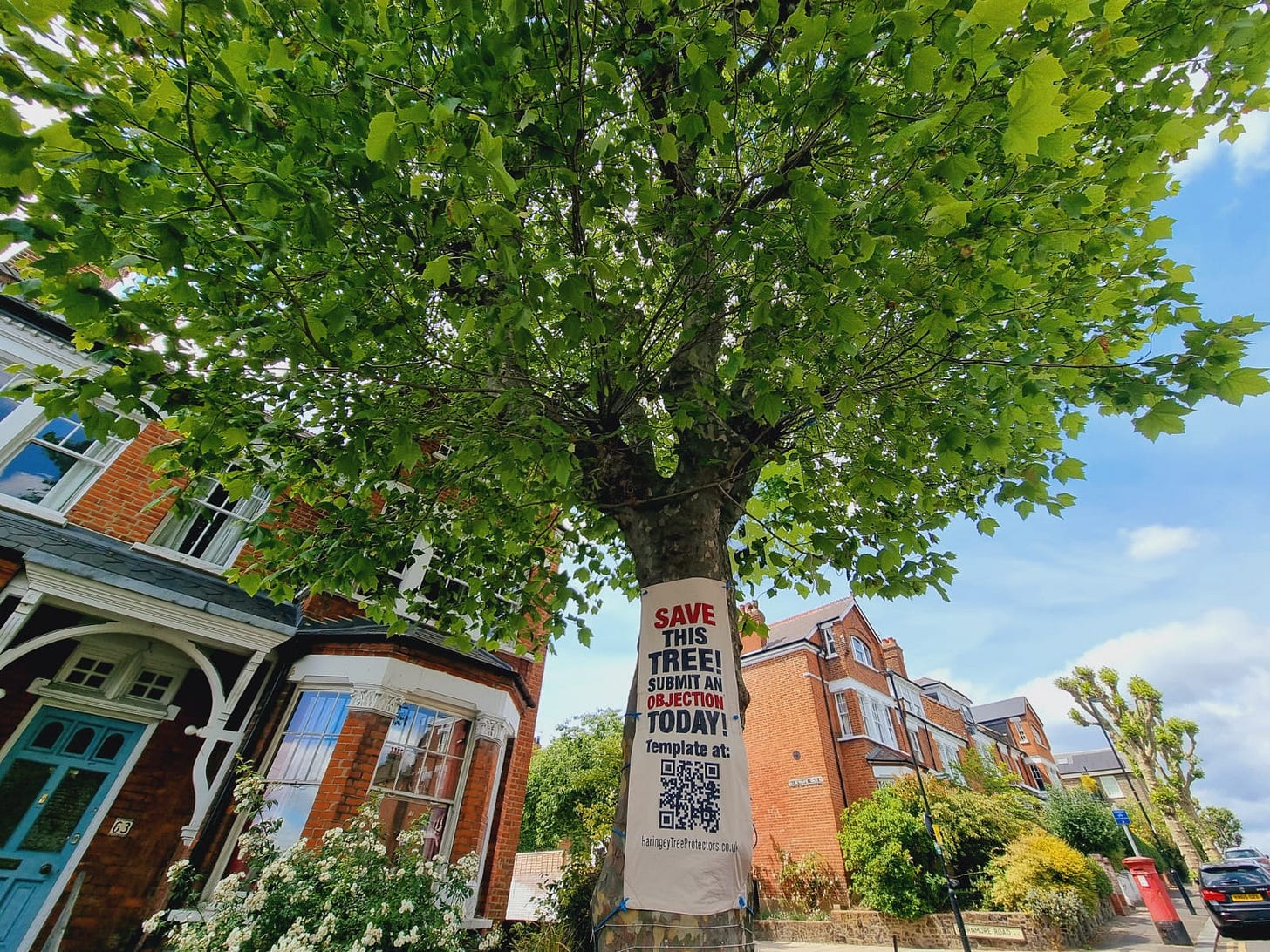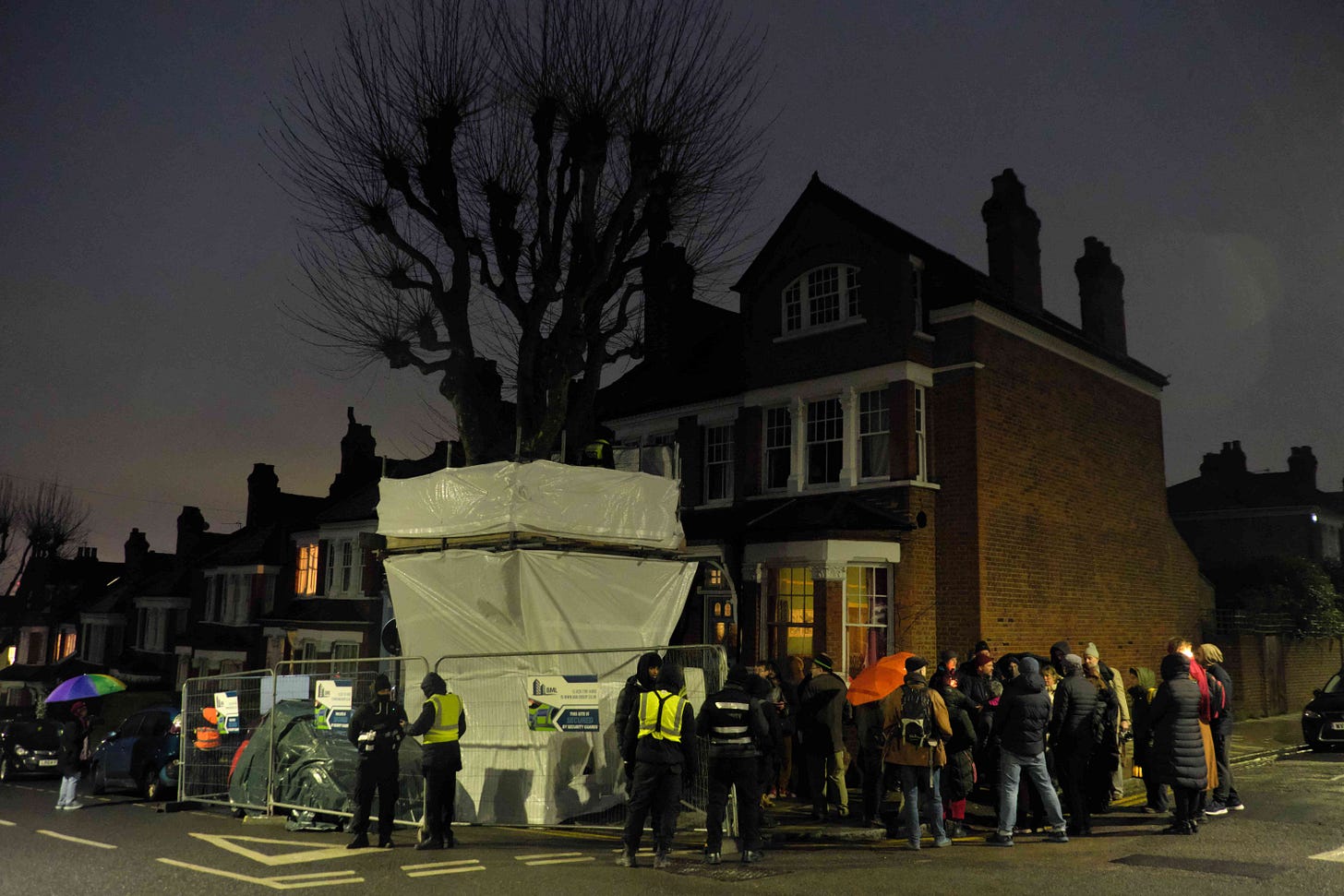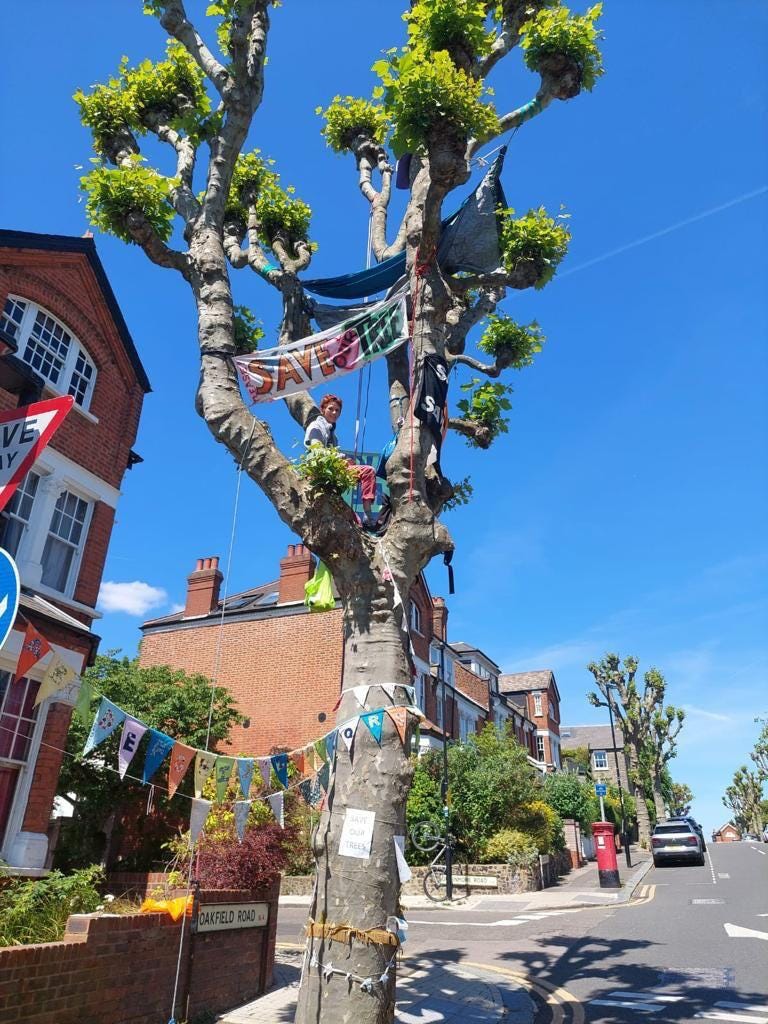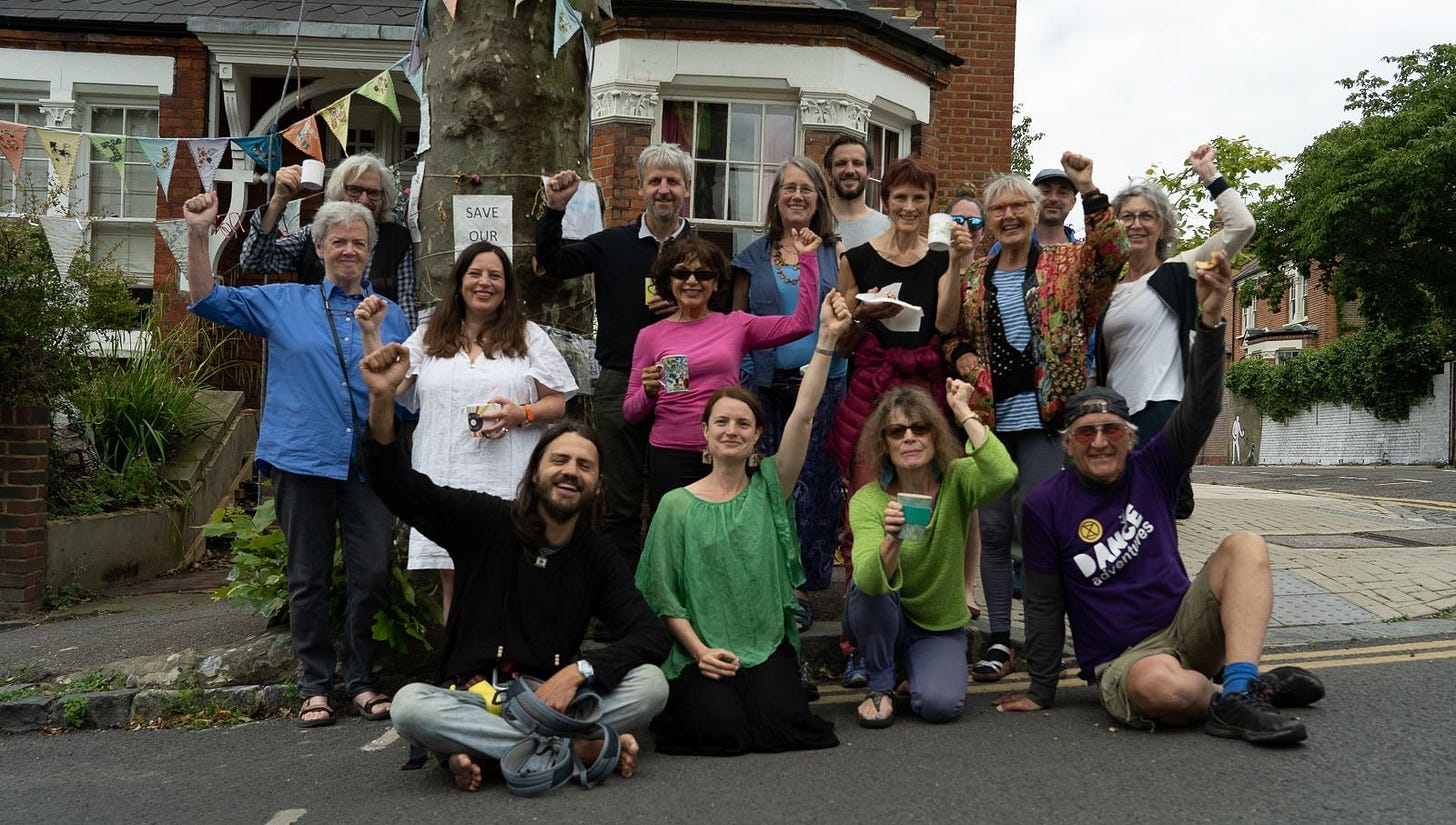A TST Long Read. Long Reads is an occasional series of longer articles written by guests for The Street Tree.
Dr Gio Iozzi chairs the Haringey Tree Protectors who campaign to protect mature trees in Haringey, north London. Their current campaign involves a 120-year-old plane tree on Oakfield Road, Stroud Green, a test case aiming to shine a light on the UK home insurance industry whose policies result in the felling of 1000s of healthy trees in the UK. They want as many people as possible to respond to the council’s tree consultation, you don’t have to be a Haringey resident to do so: a template and quick links to the council form can be found here. (Deadline is June 17th )
Gio also co-founded Canopy, the national coalition of tree campaigners along with Ali White of Straw Plymouth.
Spring 2022 – How it begins
On a hot March day I notice a council sign hanging off a London plane tree at the end of my road. The tree is said to be causing damage to a nearby house, date of execution: a week from now. The majestic tree already looks doomed, red and white tape flapping off the tessellated bark of its trunk.
I knock at the door and a woman appears. She tells me that there was no warning given about the plan to fell and begins to describe a complex Kafkaesque history, a house insurance claim that had been rumbling on for two decades, underpinning agreed to, but never properly done, years of insurer and loss adjustor avoidance, how much the tree is loved and how much they just want the insurers to do the work. As I listen, I look up at the fine London plane tree, gleaming with vitality, its leaves susurrating in the breeze, then back down at the dusty chaos left by an engineering inspection in her front garden.
Walking back to my house, anger rising up for my neighbour but also for the plight of the tree, I wonder if there is any way to stop it happening.1
The campaign
One moment, one tree, one wave of indignation and 3 years later, we’re still fighting to save this tree which has been at the centre of a long campaign involving us tree activists, council tree/legal depts, billion-pound insurers Allianz and Aviva, numerous court hearings, a judicial review, public meetings and a community uniting to protect it, including separately, the homeowners themselves.
In the year from the council’s first intention to fell, our group, the Haringey Tree Protectors guarded the tree round the clock, climate activist Marcus Decker slept in its branches for more than 150 nights and the story was covered by national and global press.
At one point, in a spectacularly ill-advised move, the council pounced on the tree in a dawn raid, erecting a prison-like fortress around the tree to take possession of it. According to sources, they thought we were going to occupy the tree again - but we had no such plan. We watched in horror as men bolted scaffolding high up through its branches, wrapped it in white tarp, slid in wooden viewing platforms and stayed for a week with a 24-hour security operation and more than 10 masked guards. This insane move turned our leafy conservation area into something that looked like a totalitarian state and cost the council £92,000.
And now?
Despite both insurers finally agreeing to settle with the two houses, clearing the way for underpinning to go ahead (a victory), the council still plans to fell the tree. Why? We are not entirely clear; the council points to historical damage (but the situation has changed as underpinning is going ahead), they say that management hasn’t worked (the tree hasn’t been pollarded for 3 years, while every other plane tree on the street was pollarded during the winter of 2024/25), that other solutions such as root blockers wouldn’t work (why not try?). Luckily, because of a new law, the Duty to Consult on Felling street Trees (Environment Act, 2021), our whole community has a chance to represent their views.
Trees are personal and political.
Mature street trees are a neglected and maligned lot. Increasingly in London in the last decades, we have witnessed the incremental felling of thousands of older street trees, destroyed one-by-one by a variety of commercial pressures, market forces, risks set crazily high (you’re more likely to be killed by a wheelie bin than a tree), utility demands, pavement damage and diseases which sometimes could be managed (the dreaded ‘dead, diseased or dying’ justification for felling many trees sends a chill up most tree campaigner’s spines). These healthy trees, which grew over decades, sometimes centuries, are slain in mere hours by shouty men in hard hats, swinging chainsaws. The wood is sold or chipped into sawdust to end up in piles in allotments or burnt for biomass. Branches, leaves, insects, micro-organisms are hacked up, the butchered parts left in orangey-yellow piles, before being fed into woodchippers and projectile-vomited out the other side.
Despite being born in a street in Leyton with more dog poo than trees, I’ve always been really passionate about them. I have a particular soft spot for London plane trees for their size and their spread. Their slick trunks in the rain remind me of elephant skin and their vastness and height of dinosaurs. They are huge but vulnerable: their camouflaged bark absorbs pollution, parasites, pests and fungal diseases, then peels off in scales to the ground leaving a green tender skin beneath. Left to grow, they become vast swaying city-cooling-canopies that remind us that nature is living amongst us, poetically, defiantly in the diesel-slaked air.2 The plane tree is king in Stroud Green, but the trees once so proudly planted by the Victorians are increasingly threatened.
The insurance death spiral
Our tree has become a symbolic test case, highlighting the immorality and negligence of a home insurance industry that will do anything to wriggle out of their obligations to homeowners and are quite happy to let cases drag on for years. Since the droughts of the 1970s, insurers have established enough case law to set a precedent which means they only have to implicate a tree in damage for it to be felled. Very few cash-strapped councils are of course willing to risk a court battle to challenge this toxic status quo. So, this rigged system against trees continues – destroying the green lifeblood of our streets and gardens.
The finger of blame is often pointing in the wrong direction. Highly shrinkable clay soil is the main culprit causing subsidence. A surveyor with a 40-year career behind him once told me that trees are rarely the direct cause of damage to a structure and good underpinning usually works. Anecdotally, my house jolts whenever a van or lorry drives past and there are no mature trees growing outside. In Haringey, we have some of the highest claims in London as we’re on very dense clay which puts pressure on trees that need a lot of water, but many of our older houses also have poor or non-existent foundations. Underpinning well should resolve most issues of movement.
We are not sure why our council is so intent on felling our tree, but they seem to be very focused on future risk. Follow this line of reasoning and every mature tree on our streets will be felled just in case it might cause future damage. The narrative of risk dominates markets, nature compromised to make sure shareholders stay satisfied. But home insurance policies look increasingly irrational in an age of climate breakdown as insurers and councils face exponential rises in flood claims. Big canopied mature trees are sponges, getting rid of them is like cutting the ropes to the lifeboats. I was astonished to read the recent LinkedIn post by Günther Thallinger, a board member of Allianz SE (one of the insurance companies who has been active in the Stroud Green tree case) stating that the climate crisis will destroy capitalism. ‘Heat and water destroy capital,’ he opined, ‘flooded homes lose value. Overheated cities become uninhabitable. Entire asset classes are degrading in real time.’ The cognitive dissonance here is shocking. Doesn’t he know that home insurers like his continue to point the blame at the very trees that cool our streets and absorb flood water?
Tree neglect.
Mature trees are a neglected lot, often caught up in quotidian administrative processes, sometimes the 34,000 trees in my borough just seem like numbers on lists, nuisances; tree officers in vastly under-resourced teams sometimes become administrators of tree deaths, something they didn’t sign up for. Disease, which could be managed sensitively with bigger budgets and if long term green directives were really being implemented, is given as justification to steadily fell tree stock. (Almost 4000 trees have been felled in our borough since 2008. In 2022 Haringey council pointed to 200-400 cases of insurance claims against trees, there may be more now after this year’s historic spring drought.)
And Size really does matter when it comes to trees. Keeping one big mature tree is much better than planting lots of small ones. Don’t be fooled when your council says they’ll be ‘planting a small tree’ somewhere nearby to replace the huge one being felled. It’s like replacing a £1 coin with a penny.
And councils, as the public owners of trees, are taking an increasingly severe approach to pollarding, a convergence of pressure from insurers, dwindling budgets, neglect and often woefully untalented tree surgeons. (see my Guardian piece on the Banksy cherry tree). Pollarding often veers into butchery (called ‘Topping’ where the crown is sliced right off.) Let’s not forget the hidden mass removal of trees in residential gardens, for that aspirational steel and glass extension, for the patio, the car, to feed a growing obsession with curating our gardens, the outmoded neat and tidy aesthetic which nature hates, to gain ‘more light’, to protect an execrable swath of plastic turf.
Yet, for the many tree antagonists there are more people willing to fight for them and trees now hit the headlines as the Enfield Oak tree and Sycamore Gap tree have shown us. The most scandalous tree battle in recent UK history began in Sheffield in 2012, where residents raised the alarm on a council plan to take out more than 17,500 of the city’s trees for new road infrastructure. They lost over 5000 trees but saved around 12,000. In 2023, Plymouth lost 114 of its city centre mature trees overnight and the fallout from this percolates today; around the same time, Haringey council felled 117 trees in a rare arboretum to make way for housing at the St Ann’s Hospital site in Tottenham. The maligned HS2 project has felled thousands of trees and destroyed many ancient woodlands. A number of 200+-year-old heritage plane trees in Euston were felled for a HS2 carpark that will never be built.
The true figures of how many trees we are losing in the UK is patchy at best, a country with some of the lowest canopy cover in the world. Local councils are not legally obliged to keep numbers of trees felled or the reasons why, although tree mapping tech means that we will have increasing access to such information and the new ‘Duty to Consult’ may bridge some of this gap. In 2017, a journalist sent a freedom of information request to over 30 councils and found that some 50,000 trees were felled in the previous five years. Another Sunday Times investigation from 2018 offers a much worse figure, that 110,000 trees were chopped down by a number of councils in just three years. A journalistic piece last year (2024) for the i-paper found that councils had felled over 455,000 trees in the last decade. Whatever the true number really is, one mature tree felled becomes another, then another and soon, streets are bare, and the sight of removal becomes normalised.
Be emotional.
Our tree is still standing, but for how long? I have been told I get too emotional about trees, it’s ‘just one tree’. But what are trees, if not, pure emotion in plant form? Their spring displays are still-lives of whispering leaves, fruit and blossom. On the hottest days, they drape nets of shade on our pavements, softening and cooling the edges of our burning urban concrete spaces . Trees undulate just as feelings do, tremble, shake and sway. They are sociable species, they communicate, prefer living in groups and they look out for one another. Trees experience pain, develop relationships, they feel. As Peter Wohlleben writes, ‘Under the canopy of the trees, daily dramas and moving love stories are played out.’3
Who is fighting for our mature street trees? Not our government, not our councils, certainly not insurers. It’s up to us residents, whole streets, communities, the people who really care about these green giants who do so much for our health, spirit, our hearts, our minds.
Don’t be scared, make a stand, knock on a neighbour’s door. Your faith in human nature will be restored; you’ll be wonderfully surprised by how many people join you.
Threats to mature trees are increasing – from insurance companies who blame them for subsidence, urban development, cash-poor councils who see them as too expensive to maintain, car owners (who hate leaf droppings) to tree vandals and van drivers who smash into branches. But canopy shades and cools us, helps our physical and mental health, absorbs flood water, provides habitat and in cities, temperatures can be 10 degrees cooler under tree canopy.
London Plane trees (platanus x hispanica) are a hybrid of the American Sycamore and Oriental Plane). The Victorians began planting them in 1870 along the Embankment. Many are more than 100 years old, some 40-metres tall. Their bark has a distinctive camouflage patterning which absorbs pollution and then sheds off like snakeskin. They thrive on cool winters, plenty of water and heatwaves.
The Hidden Life of Trees, Peter Wohlleben (2017)








Have you tried vontacting Herr Thallinger of Allianz, drawing his attention to the effects of his company's actions, and pointing out his inconsistency?
Right with you, Gio, thank you. Insurance is utterly abhorrent in its huge detriment to society, from trees to activities, plus the fetish for clean and neat and easy, nothing must require effort or risk, especially to a shareholder.